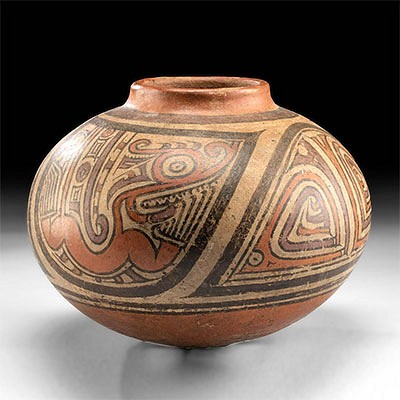Lot of 2 Early 18th C. Western European Wood Medallions
Lot 202
About Seller
Artemis Fine Arts
686 S Taylor Ave, Ste 106
Louisville, CO 80027
United States
Selling antiquities, ancient and ethnographic art online since 1993, Artemis Gallery specializes in Classical Antiquities (Egyptian, Greek, Roman, Near Eastern), Asian, Pre-Columbian, African / Tribal / Oceanographic art. Our extensive inventory includes pottery, stone, metal, wood, glass and textil...Read more
Categories
Estimate:
$500 - $750
Absentee vs Live bid
Two ways to bid:
- Leave a max absentee bid and the platform will bid on your behalf up to your maximum bid during the live auction.
- Bid live during the auction and your bids will be submitted real-time to the auctioneer.
Bid Increments
| Price | Bid Increment |
|---|---|
| $0 | $25 |
| $300 | $50 |
| $1,000 | $100 |
| $2,000 | $250 |
| $5,000 | $500 |
| $10,000 | $1,000 |
| $20,000 | $2,500 |
| $50,000 | $5,000 |
| $100,000 | $10,000 |
| $200,000 | $20,000 |
About Auction
By Artemis Fine Arts
Apr 15, 2021
Set Reminder
2021-04-15 10:00:00
2021-04-15 10:00:00
America/New_York
Bidsquare
Bidsquare : VARIETY SALE | Ancient & Ethnographic Art
https://www.bidsquare.com/auctions/artemis-gallery/variety-sale-ancient-ethnographic-art-6811
Featuring classical antiquities, ancient and ethnographic art from cultures encompassing the globe. Egyptian, Greek, Roman, Etruscan, Near Eastern, Asian, Pre-Columbian, Native American, African / Tribal, Oceanic, Spanish Colonial, Russian, Fossils, Fine Art, more! Artemis Fine Arts info@artemisfinearts.com
Featuring classical antiquities, ancient and ethnographic art from cultures encompassing the globe. Egyptian, Greek, Roman, Etruscan, Near Eastern, Asian, Pre-Columbian, Native American, African / Tribal, Oceanic, Spanish Colonial, Russian, Fossils, Fine Art, more! Artemis Fine Arts info@artemisfinearts.com
- Lot Description
Western Europe, Germany and Spain, German one after Martin Brunner (German, 1659 to 1725), ca. early 18th century CE. A fine pair of carved-wood medallions; the first commemorating civic events and the second religious. Surrounded by a floral border on both sides, the first medal is from Germany and was carved after Martin Brunner (1659 to 1725). One side of this skillfully-carved medallion displays an allegorical scene of a peace treaty with a pair of women, representing Justice and Peace, embracing each other as one holds a sword, representing victory, and the other grasps an olive branch, symbolic of peace. Mars, the Roman god of war, lounges behind them. An inscription below the scene reads, "Ruswicensis / 1697", indicating that the medal was intended to commemorate the Peace of Ryswick; a series of treaties made between September 20th and October 30th in 1697 that attempted to end the Nine Years' War. A Latin inscription above the women reads "OSCULA IUSTITIA PAX AUREA FICIT IN ORBE", translating to "Golden Peace has implanted the kiss of Justice in the world". A sun containing the letter L is shown above the women, while a crescent moon hangs low behind a cloud in the lower right, representing that Leopold I will take rule and bring peace and justice to Europe. Alternatively, the verso displays two extravagantly dressed nobles seated beside a tree - a man and a woman. The woman leans to touch a rose bush as a petite cherub peaks out from behind her shoulder to stop her. Written above is "TRAU NICHT ES STICHT", which is German for "Don't trust, it stings". This medallion likely would have served as a game piece and the inscription on this side would serve a cautionary purpose; to warn players against hasty trust upon first sight. Size (the same for both): 2.2" in diameter (5.6 cm)
The second medallion focuses on Catholic subject matter and is also encompassed by a floral border on both sides. One side displays a diademed Virgin Mary standing and holding a staff in one hand and baby Jesus in the other as her long hair flows behind her. The infant god raises a globus cruciger as a haloed man holds rosary beads and bows before them. The man's halo signifies that he is a saint and his tonsure indicates that he is of a religious order, perhaps Franciscan, Dominican, or Jesuit. Above the group the Latin words "O.S. MARIA PRO NOBIS" ("Saint Mary pray for us") are written. The verso of the piece shows another monk or person of a religious order, as evident via his tonsure, standing right and holding up a cross as he preaches to a group of five men. The masts of two ships can be seen in the background. Above him is inscribed, "FIDEM TRANSVEXIT AD INDOS" (He brought faith to the Indians). Due to the subject matter of saints and missionaries, it is more likely that this medallion is from Spain, a country known for their Catholic missions to the Americas, rather than Germany.
Provenance: ex-Estate of Eldert Bontekoe, Pegasi Numismatics, Ann Arbor, Michigan USA acquired before 2000
All items legal to buy/sell under U.S. Statute covering cultural patrimony Code 2600, CHAPTER 14, and are guaranteed to be as described or your money back.
A Certificate of Authenticity will accompany all winning bids.
We ship worldwide and handle all shipping in-house for your convenience.
#158143German medallion has petite chip to periphery and small area of staining on one side. Both pieces have minor abrasions to both sides, with light softening to some finer details and raised text, otherwise intact and very good. Rich patina throughout.Condition
- Shipping Info
-
All shipping is handled in-house for your convenience. Your invoice from Artemis Gallery will include shipping calculation instructions. If in doubt, please inquire BEFORE bidding for estimated shipping costs for individual items.
-
- Buyer's Premium



 EUR
EUR CAD
CAD AUD
AUD GBP
GBP MXN
MXN HKD
HKD CNY
CNY MYR
MYR SEK
SEK SGD
SGD CHF
CHF THB
THB













